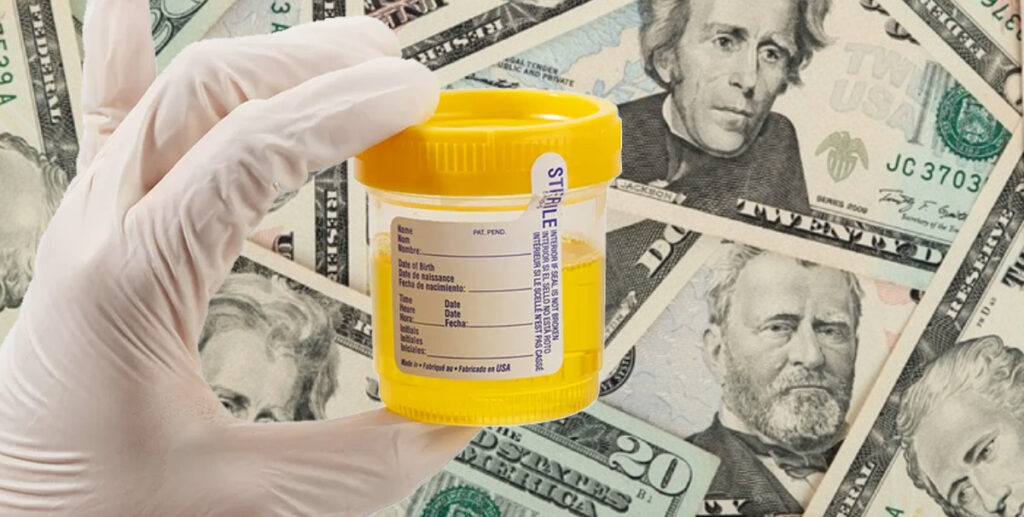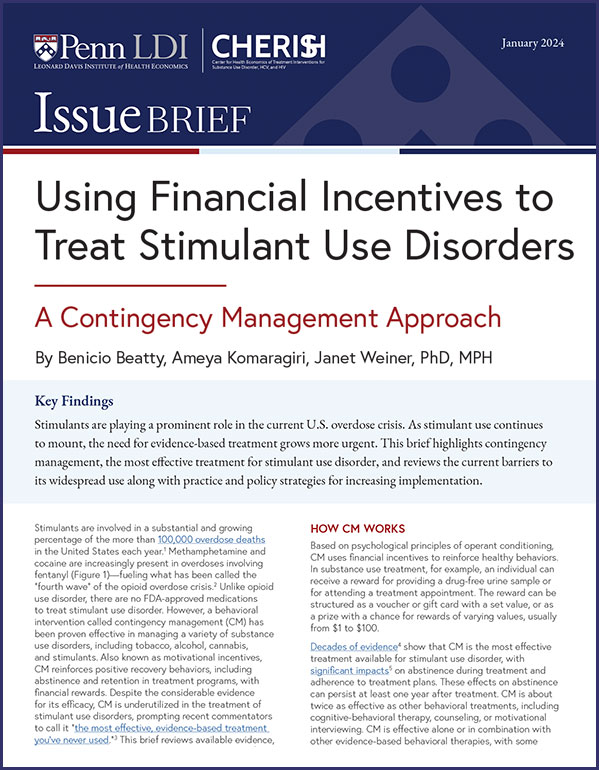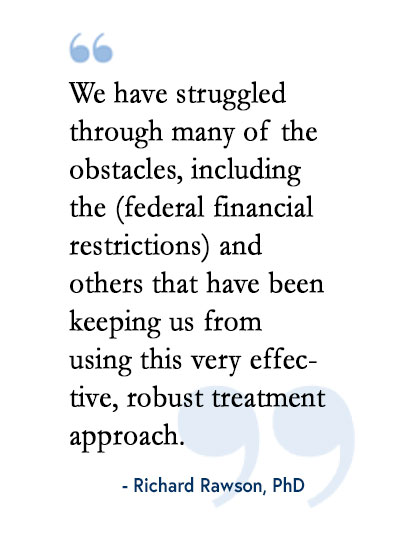
Over 500 U.S. Hospitals Have Stopped Delivering Babies Since 2010
A Crisis in Maternal Care is Unfolding—and it’s Hitting Rural and Urban Communities Alike
Substance Use Disorder
News

So, imagine there’s a runaway epidemic of overdose deaths that involve non-opioid drugs and that we’ve had an evidence-based therapy for this unique addiction for the last forty years—but for reasons largely grounded in legislators’ and the public’s visceral disdain for people who use substances, we have refused to nationally recognize or widely implement this treatment method.
This is, of course, not an imaginary situation, but a statement about the current record-setting rise in the number of addicted users and overdose deaths driven by both opioids and stimulants like methamphetamines and cocaine. Stimulant substances are very different from opioids. They do not have overdose reversal or treatment medications analogous to the naloxone or buprenorphine of the opioid substance use world.

However, there is a treatment that does works in this substance users subgroup.
Decades ago, pioneers in the then-emerging field of behavioral economics began testing incentive interventions designed to motivate individuals in activities like tobacco cessation, healthier eating habits, exercise frequency, and other health behaviors. The researchers found that offering small amounts of cash or prizes when certain behavioral goals were met did have significant results. The science involved was called “operant conditioning” or positive reinforcement. Since then, “health incentives” have become part of standard practice used in the above-mentioned behavioral conditions.
One of the effective approaches tested back then is now called contingency management (CM), a behavioral therapy in which individuals in stimulant use treatment programs receive small cash and prize awards for achieving short-term recovery-oriented behaviors, such as producing negative urine samples or abstinence from drug use over a specific period.
Although the tight focus in the national debate about this controversial approach has been exclusively on the money prizes, there is psychological value beyond those small financial incentives that is not well understood. For instance, it is believed that the brain experiences a sense of pleasure and satisfaction from such recurring rewards that can strengthen the neural pathways associated with positive behavior. In addition, for individuals with addiction who live in isolation and frequently suffer with low-esteem and doubts about their abilities to change, the impact of the rewards—as well as the enveloping community environment in which they occur—can have an outsize impact on a person’s overall outlook and behavior within the drug recovery therapy program.
But despite this proven effectiveness, CM has long generated little funding or implementation interest in federal or state agencies until now. In its latest 2023 report, the Department of Health and Human Services (HHS) reports, “Stimulants are the fastest-growing category of substances involved in overdose deaths. Between 2020 and 2021, the rate of deaths involving psychostimulants with abuse potential, such as methamphetamine, increased 34%—a more rapid rate of increase than for overdose deaths involving opioids.”
In an effort to explore the full potential and current obstacles to faster implementation and wider use of CM to address this national crisis, the University of Pennsylvania’s Leonard Davis Institute of Health Economics (LDI) and Center for Health Economics of Treatment Interventions for Substance Use Disorder, HCV, and HIV (CHERISH) convened a virtual conference entitled, “Incentivizing Recovery: Payment, Policy, and Implementation of Contingency Management.”

One point of consensus among the panelists was that there has been a woefully small amount of public storytelling about the positive aspects of CM and its potential impact on stimulant substance use and the overdose epidemic. Simply getting the knowledge of CM out there is seen as one of the keys to generating more backing and action from state and federal health policymakers.

Helping to kick off the discussion with his own story was panelist Richard Rawson, PhD, a Professor Emeritus at the UCLA Department of Psychiatry and Research Professor at the University of Vermont. Involved in addiction work since the 1970s, he explained that in the 1980s his clinic saw a dramatic increase in the number of people seeking treatment for stimulant use disorder.
“We tried cognitive behavioral therapy, medications, and everything else we could think of, but not much worked,” Rawson said. “In the early 90s, I read a contingency management paper by Steve Higgins, PhD, from the University of Vermont but I didn’t believe his data because it was so much better than what I was doing. I went to Vermont to visit and then got some grants to run some CM studies. And, indeed, CM did work a lot better than what I had been doing. Ever since then, I’ve been a major advocate for CM and have struggled through many of the obstacles, including the (federal financial restrictions) and others that have been keeping us from using this very effective, robust treatment approach.”
Addressing the widespread resistance to CM, panelist Michael McDonell, PhD, Director of Promoting Research Initiatives in Substance Use and Mental Health (PRISM) Collaborative at Washington State University, cited stigmas as “a major barrier in all of this.”
“There’s a huge amount of stigma around substance use disorders and treatment in general and an additional layer of stigma when you talk about offering people money to stop using drugs,” McDonell said. “The belief that people should be intrinsically motivated to change their behavior is something that permeates so many different levels of this issue.”

“However,” McDonell continued, “what we’ve seen in research is that such views can be overcome pretty easily by education. Once you see a client walking down the hall with a prize that they won or a $100 gift card they’ve just received, and they tell you why, and you see the smile on their face and see this same thing happening a couple times over six weeks, and then you hear that that person hasn’t been using stimulants for a month, you know that that’s all it takes to change a clinician’s mind.”
And at least the highest echelons of HHS have begun to change their thinking about CM. The agency’s latest 2023 report catalogs the barriers it hopes to overcome as it sets out to expand the use of CM. Aside from stigma, it lists “federal fraud and abuse laws, limited funding, restrictions on the kind of drug treatment CM can be used on, a low level of public knowledge about the methodology’s solid scientific footing, the workforce challenge of insufficient numbers of clinicians and counselors trained in the specialty, and the limited availability of CM training and mentoring venues.”
In a contrary approach begun back in 2011, the Veterans Health Administration (VA) determined that CM was an effective, scientifically proven methodology and made it a routine part of the substance use treatment programs across its network of medical centers and clinics that serve nine million veterans. Instead of cash prizes, the VA CM programs emphasize the use of Veterans Canteen Service (VCS) vouchers as prizes awarded for negative urine samples and other aspects of achieved treatment success.

Panelist Kait Hirchak, PhD, MHPA, a descendant of the Eastern Shoshone Tribe and an Assistant Professor at Washington State University has been researching substance use disorder in tribal communities that have high levels of stimulant use. She noted how the incentives of tribal CM programs have been altered according to local cultural values, with patients being rewarded with beading supplies and medicine kits. She also pointed out that American Indian and Alaska Native tribes are sovereign and get to decide on their own what gets implemented and paid for in CM programs.
The nature and value of incentive prizes given to a CM patient in a year’s time is a central choke point in the national debate about CM.
There is a great deal of confusion surrounding this issue driven by funding restrictions of the Substance Abuse and Mental Health Services Administration (SAMHSA) and a 2008 opinion issued by the HHS Office of Inspector General (OIG).
Federal rules bar clients in substance use treatment programs from receiving more than $75 worth of behavior change incentives. That limit has been criticized by the panelists and their organizations as providing too little money to accomplish CM’s goals.
A separate 2008 OIG opinion said “The anti-kickback statute makes it a criminal offense knowingly and willfully to offer, pay, solicit, or receive any remuneration to induce or reward referrals of items or services reimbursable by a federal health care program… For purposes of the anti-kickback statute, ‘remuneration’ includes the transfer of anything of value, directly or indirectly, overtly or covertly, in cash or in kind.”
The exact meaning of the full OIG opinion’s legalese has been debated ever since. One widely believed interpretation is that, like SAMHSA restrictions, it allows no more than $75 in prize money or value can be paid annually from federal funds to any individual in a CM drug treatment program.
A second OIG opinion issued in 2022 amended the first by saying, “We are aware that some industry stakeholders may be under a misimpression that OIG prohibits contingency management program incentives above $75. There is no OIG-imposed $75 limitation on contingency management program incentives.” However, it also went on to say, “In-kind incentives above the $75 annual, aggregate limit, and all cash or cash-equivalent incentives regardless of the amount, must be analyzed on the basis of their specific facts for compliance with the Beneficiary Inducements Civil Monetary Penalty (CMP).”
In the last several years a few states have pioneered several different ways to support CM incentive programs with significantly higher amounts of money for patient prizes and other services. The largest has been the 2022 launch of the California Advancing and Innovating Medi-Cal (CalAIM) Contingency Management Pilot Program made possible by a Medicaid waiver and $58 million in state funding.
“We saw great advocacy in California for a program with robust resources that addressed all the things we’ve been talking about here,” said McDonell. “They were able to bring in experts of all kinds for the program design and waiver application.”
“At the same time, we’re now seeing encouragement from the federal government that states interested in doing this CM work should really go after a Medicaid waiver, because once you have a waiver, CM incentives are covered as a benefit,” said McDonell. He also pointed out that several states he has been working with are pursuing approval for a total annual incentive-per-patient amount of $599. The odd amount is the highest possible before the payments would become taxable income at $600.
Beyond the Medicaid waivers, a few other states have been creatively using funds from their opioid settlement funds, state opioid response funds, and even alcohol tax funds to cover the incentive costs of their CM programs for stimulant users.

McDonell said one of his frustrations is that at the talks he gives on CM, people in the audience get fired up and excited about the concept and then ask him how they will fund the incentives if they start such a program? “We often say they might get donated prizes to use or apply for a grant and other alternatives like that. But if you think of CM as the medical intervention that can be lifesaving, I think that our answer is just insufficient,” he said.
Panel moderator Jonathan Purtle, DrPH, MPH, MSc, Director of Policy Research at New York University’s Global Center for Implementation Science agreed. “I think it’s a shame to say the least, that for such a lifesaving intervention, we need to be so creative in our financing. But we do need to be. That’s the policy reality right now.”
Rawson agreed and argued that the policy needs to be changed. “The first and most obvious way to solve this issue is for the federal government to eliminate the $75 cap. I believe that could be done administratively in a way that makes adequate CM funding available nationally. By far, these other alternative funding strategies are in second place,” he said.

Panelist Robert Baillieu, MD, MPH, FAAFP, a physician and advisor at the Center for Substance Abuse Treatment (CSAT) of SAMHSA said, “We absolutely understand that $75 per patient per year in incentive amounts is not evidence-based. However, before that’s changed, there are so many things that need to be considered. We need to think about equitable application of this to tribal communities, to different populations, and different cultural considerations. We need to consider how CM programs can be delivered equitably and comparatively across different departments of HHS. So, SAMHSA is one entity here.”
“The Health Resources and Services Administration (HRSA) supports CM through some of their programs. The Department of Agriculture has a CM grant as well. So, thinking about how we create policy that can apply across federal entities and how those different policy pieces can support the equitable implementation of programs is not an easy task,” Baillieu said.
“And, unfortunately,” Baillieu continued, “in the reality of federal funding, these programs also need to demonstrate return on investment. So, thinking about how our guardrails and future funding plans could potentially promote those metrics of comparability and scientific measurability is really important.”


A Crisis in Maternal Care is Unfolding—and it’s Hitting Rural and Urban Communities Alike

Stable Payments Improved Margins But Not Liquidity, New LDI Analysis Finds

LDI Senior Fellow Cited for “Significant Contributions” in Research

Outdated Laws Target Black and Queer Lives in Over 30 States, Fueling a Deadly Disease

Selected for Current and Future Research in the Science of Amputee Care

Research Memo: Delivered to House Speaker Mike Johnson and Majority Leader John Thune